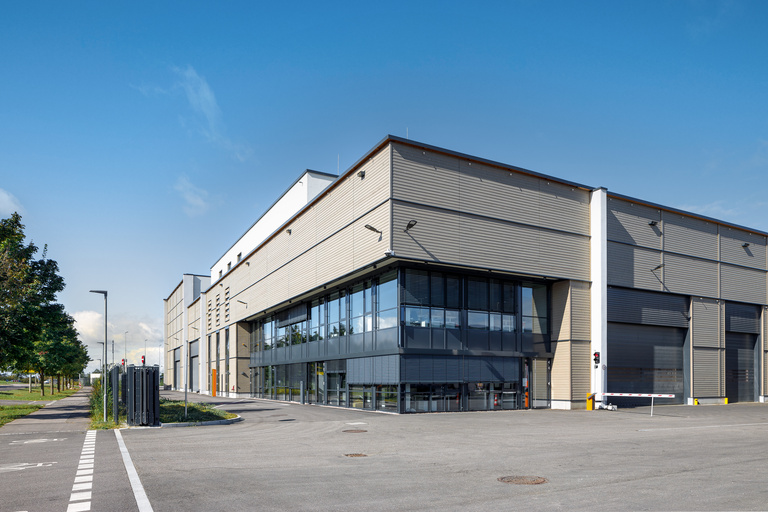Eschbach, Germany, April 4, 2025. While the recently planted trees are still taking root outside on the site, sustainable wooden insulation boards have for weeks already been rolling off the production line inside the newly built plant of Gutex Holzfaserplattenwerk H. Henselmann GmbH + Co. KG in the Breisgau Business Park. Located around 30 kilometers south of the city of Freiburg, directly on the A5 motorway, the new plant covers an area of around six hectares. It combines administration, production and administration under one roof. Short delivery routes for the raw material – timber – and proximity to the core markets in Germany, France and Switzerland are major features of the new location where the three countries’ borders all meet. Moreover, the focus is on sustainable energy solutions for a carbon-neutral production process. Gutex uses green electricity, is committed to biomass and utilizes the process heat from a neighboring waste incineration plant in the production process. The construction project started in January 2022 and was successfully completed in November 2024. The Eschbach-based company availed itself of the expertise of Drees & Sommer SE, which is headquartered in Stuttgart and specializes in advice on construction and real estate.
“Due to the new location, we are now able to obtain the timber for our sustainable woodfiber insulation boards not only from the Black Forest or Switzerland, but also from the Vosges mountains. And this is beneficial for our carbon footprint,” says Managing Director Claudio Thoma on the occasion of the successful start of production. As the fourth-generation head of the company, he is well aware of his responsibility for forward-looking climate action: “Our goal is not only to meet the individual needs of our clients, but also to actively take responsibility for future generations. The new plant in Eschbach will achieve this.”
Successful with Lean Construction Management
Drees & Sommer supported Gutex in the construction of the new plant in Eschbach by providing a wide range of project management services. Drees & Sommer’s expert team headed by Daniel Petran applied Lean Construction Management (LCM) to coordinate the planning activities and implement the construction and plant technology. Originally developed in the automotive industry, this approach aims to organize the entire construction process – from planning through execution to follow-up – in a collaborative, transparent, agile and highly efficient way. All project steps and processes are scheduled exactly to the day and displayed visually for everyone directly at the construction site, on a planning board with stick-on cards. "This enabled us to identify potential challenges at an early stage, react quickly to changes and bring stability to the planning and construction process," says Manuel Vogt, Senior Lean Consultant at Drees & Sommer. “The close collaboration between all participants also helped to save time and costs,” adds the expert from Drees & Sommer.
In addition to the provision of project management services, Drees & Sommer’s construction management specialists were involved in quality assurance activities during the project completion phase. However, according to team head Daniel Petran, to make the collaboration as smooth as possible, especially during this completion phase „ongoing, active communication and regular feedback between everyone involved,” were needed above all.
From Tree to Climate-Friendly Building Material
Wooden insulation boards are increasingly in demand in the construction industry. They consist of renewable raw materials such as scrap wood and are able to bind CO₂. On average, they store more than six metric tons of carbon dioxide per single-family home. This is equivalent to the amount of emissions that commuters cause in six years when going to and from work.[i] This makes the boards a real carbon sink in the construction sector," explains Claudio Thoma. Another advantage of woodfiber boards is their excellent protection against cool and hot temperatures, by providing effective insulation in both winter and summer. This also helps to reduce heating costs. With a service life of over 50 years, they not only contribute to lowering a building's energy requirements, but also to cutting greenhouse gas emissions. At the end of their useful life, the materials can either be recycled as materials, composted, or thermally utilized after being dismantled and separated into raw materials of the same kind; only the previously bound CO₂ is released.
Sustainable Energy Supply: Photovoltaics, Biomass and Process Heat
The new location in the border triangle region is committed to applying advanced approaches to energy. Particularly noteworthy is the modern photovoltaic system. It produces green electricity and covers a large part of the plant's energy requirements. “In this way, we reduce our dependency from fossil fuels,“ explains Oliver Bauch, Plant Manager at Gutex. In the long term, solar energy saves operational costs, and it makes sense both economically and ecologically. In addition, a biomass plant on the site provides process steam and heat by using the firm’s own bark and wood chips to generate energy. "This optimizes the use of resources," comments the expert on sustainable insulation boards. A nearby waste incineration plant also supplies heat. The combination of renewable energies ensures a sustainable and efficient supply of energy.
[i]VHD: Dämmstoffe aus Holzfasern binden das Treibhausgas CO2 - Renewable Carbon News
[page available in German language only (Woodfiber insulation materials bind carbon dioxide greenhouse gas.)]
